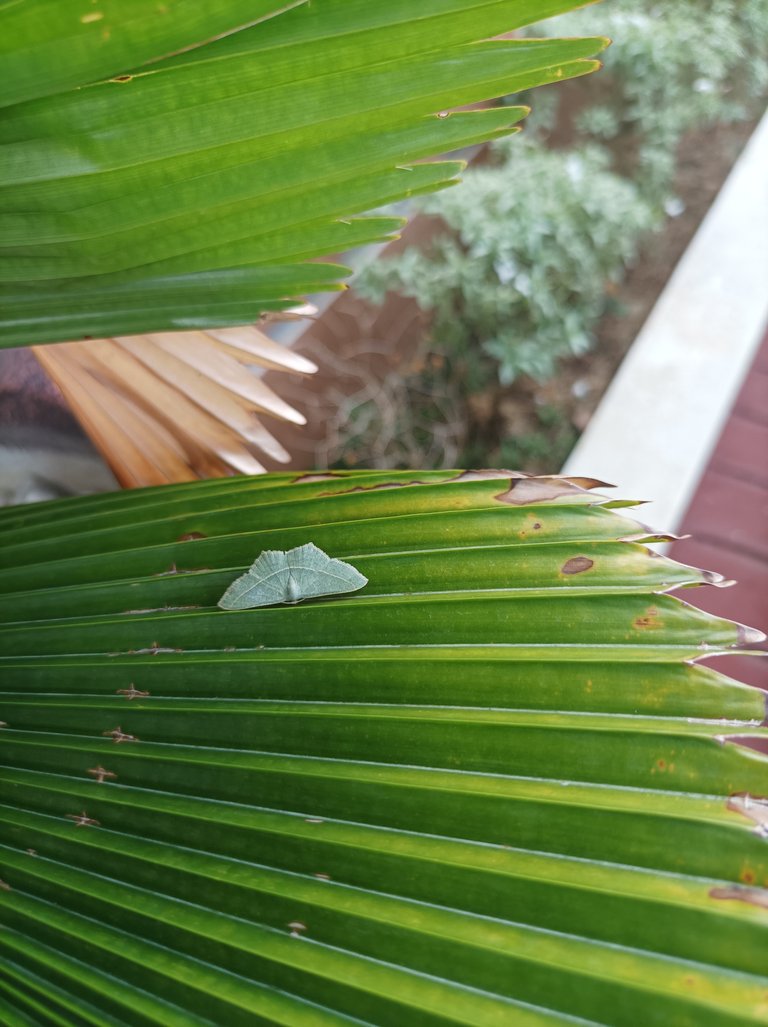Good afternoon hive friends all, have a nice day and of course you can do the things you like and what you want wherever and whenever you want. On this occasion, of course, I am in good health and of course I can do the things that I like.
One of the things I really like is that on this occasion I want to share with my hive community friends, is a photo of an insect creature called a moth and in my area it is very rare to find this type of animal.

Moths are insects closely related to butterflies and both belong to the Order Lepidoptera. The difference between butterflies and moths goes beyond taxonomy.
Sometimes the names Rhopalocera (butterfly) and Heterocera (moth) are used to formalize their distinction. Many attempts have been made to divide the order Lepidoptera into groups such as Microlepidoptera and Macrolepidoptera, Fenatae and jugatau, or Monotrysia and Ditrysia.
The failure of this name to survive in modern classifications is because neither of these classifications represents a monophyletic group. In reality, butterflies are a small group that emerged from "moths".
#The influence of moths on the economy
Most species of moth are active at night, but some are active in the evening and morning, as well as during the day.
Moths and their caterpillars are major agricultural pests in many parts of the world. The caterpillar of the gypsy moth (Lymantria dispar), an invasive species causes severe damage to forests in the northeastern United States.
In temperate climates the codling moth causes severe damage especially to orchards. In the tropics and subtropics the cabbage caterpillar (Plutella xylostella) is perhaps the most vicious pest of cabbage plants.
Some moths in the Tineidae family are often considered pests because their larvae eat fabrics such as clothes and blankets made from natural fibers such as wool and silk, but they usually do not eat materials mixed with artificial fibres.
Camphor is the most commonly used moth repellent and is considered to be moderately effective but there is concern about its effects on human health.
Moth larvae can be killed by freezing the items they attack for several days at temperatures below -8 degrees Celsius.
Moths are quite hardy and less susceptible to exterminators than mosquitoes and flies.
Some moths however are also useful and domesticated such as the silkworm, the larvae of the domestic moth Bombyx mori.
Silkworms are raised for their cocoons. Not all silk is produced by Bombyx mori as there are several Saturniidae species that are also farmed for their silk such as the Ailanthus moth (a member of the Samia cynthia group), the Chinese oak silk moth (Antheraea pernyi), the assam silk moth (Antheraea assamensis), and the Japanese silk moth (Antheraea assamensis). Antheraea yamamai).
The mopane caterpillar, a caterpillar from Gonimbrasia belina, from the Saturniidae family, is a food source in South Africa.
It should be noted that adult moths do not eat fabrics. Large moths such as Lun, Polyphemus, Atlas, Prometheus, Cercropia, have no mouth and they drink nectar for food.
#Interest in light
Moths can be found circling artificial light. One hypothesis put forward to explain this phenomenon is that they use a star navigation technique called latitude orientation.
By keeping a steady angle with a bright sky object (the moon) the moth can fly in a straight line.
This celestial object is so far away that even after flying far there is no significant difference in angle but it will be different with artificial light.
Human-made light hasn't appeared long enough to influence the evolution of moth navigation systems. When the moth finds a closer artificial light and uses it for navigation, its angle changes significantly after traveling that close distance. The instinct of the moth tries to correct this by turning towards the light and this eventually results in a spiral flight pattern that draws closer and closer to the light source.
This can be fatal to the moth if the artificial light source kills it such as a candle or insect repellant.
Another theory that has been proposed to explain the male moth's attraction to wax is based on the sense of smell.
There is evidence that smell may, in some cases, be mediated by detecting the infra-red spectra of a substanceand the infrared spectra of a candle flame happen to contain emission lines similar to the pheromone vibrational frequency of female moths that attracts her to scent candle fire.
Flowers that bloom at night usually depend on moths (or bats) for pollination, and artificial light can attract moths away from flowers that need them. A way to avoid this is to put cloth or netting around lights or use colored lights (red is preferred) to dissuade moths from the artificial ligh.
-The famous moth
*Death of Hawkmoth Acherontia sp.
*Moon Moth Actias luna
*Atlas Moth Attacus atlas The largest moth in the world
*Emperor Gum Moth Opodiphthera eucalypti
*Moth Polyphemus Antheaea polyphemus
*Moth seasoned with Biston Betaria
-Moths with considerable economic influence
*Lymantria dispar Gypsy moth
*Cotton bollworm or corn earworm Helicoverpa zea, the majority of agricultural pests
*Cydia pomonella moth codling, pest of the majority of apple, pear and walnut trees
*Epiphyas postvittana light brown apple moth
*Bomberx mori silkworm
*We stay Phereoeca uterella
and only this I can tell you more and less I apologize, and don't forget to always take care of your health and always support each other, see you next time.
